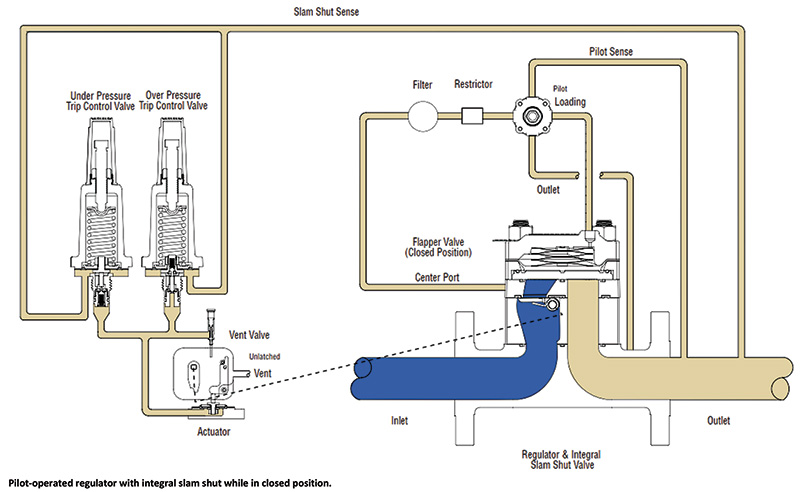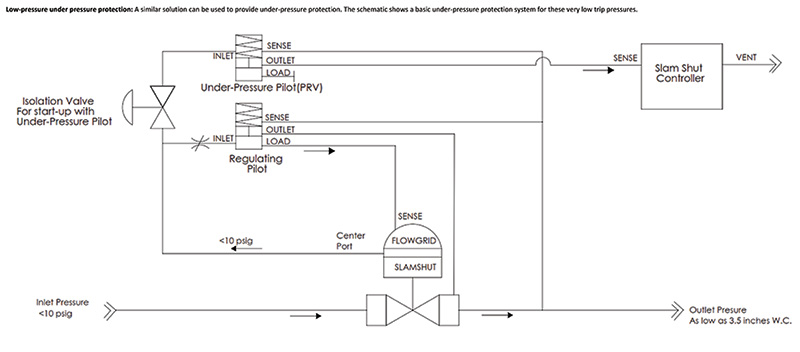September 2019, Vol. 246, No. 9
Features
Slam-Shut Technology for Ultra-Low-Pressure Protection
By John Deveau, Baker Hughes, a GE Company
Natural gas is an abundant fuel used for both industrial and residential energy and is one of the few energy sources delivered directly into our homes. Because it’s also a flammable, potentially explosive fluid, natural gas utilities and distribution companies are required to prioritize safety and devote focus to their protection systems to prevent over-pressurization accidents, even for systems operating at extremely low-pressure levels (< 1 psi).
Every natural gas system is designed and approved for a maximum allowable operating pressure (MAOP). This includes feed lines into homes that have active pilot flames to burn continuous low volume flow for furnace heating. These systems that provide final product to end-customer homes, must be designed with extremely low MAOP pressure levels, often as low as a few inches of water column (< 1 psi).
Such low-pressure systems can be even more vulnerable, as minor pressure excursions can turn a simple pilot flame on a furnace into a larger, more dangerous flame if not protected. Alternatively, minor pressure or flow loses can cause pilot flames in homes to extinguish, which upon recovery of flow would admit unburned gas directly into homes creating another potentially dangerous scenario.
Over-pressure protection equipment, or systems, are critically employed to ensure a single point of failure cannot result in exceeding the system MAOP. Natural gas supply systems vary in design and pressures, and it’s up to the utility or operator to select the appropriate safety devices for their system, in line with Federal regulations, codes, and company design standards. The following overview of slam shut over-pressure devices details one proven method of secondary over-pressure protection, that can benefit even ultra-low-pressure natural gas applications.
Slam Shut Device
Most gas pressure regulating stations include a secondary pressure regulator, called a worker-monitor system, which takes over if the primary unit fails to control. Should something go wrong with the primary worker regulator, the monitor, which is normally fully open, takes over to keep the system pressure at a safe level and maintain gas flow to the users downstream. But if something goes wrong with those secondary devices, then what?
A slam shut valve provides an additional layer of protection in the event pressure regulation is lost from both the worker and monitor regulators. Although perhaps not always desirable as a first protection method, if the regulating devices, both primary and secondary fail, a slam shut system isolates the gas flow. Unlike most relief valve systems, when a slam shut activates, the system is immediately isolated and excess gas is not vented to atmosphere.
Slam shut valves can be standalone devices or integrally designed into a pilot operated regulator, each option designed with their own sensing and control mechanisms. Its function is simple: upon sensing pressure exceeding setpoint (over pressure protection), or below setpoint (under-pressure protection), the internal mechanism is unlatched and an isolation flapper closes, stopping all gas flow. The flapper remains in that position until the regulator is manually reset.
An added benefit of the Slam shut system is the dual security provided in the case of under-pressure protection as well. Gas appliances with pilot lights are found in furnaces, water heaters, stoves, and fireplaces that are designed to operate with continuous gas supply pressure.
If the gas pressure or flow drops too low to maintain that pilot light, the gas may not be ignited when eventually delivered. If this occurs, gas could build up in the local atmosphere and potentially could ignite, resulting in an explosion. For this reason, under-pressure protection, to shut off all gas flow as pressure drops below a safe point, is also an important consideration in system design.
Low-Pressure Systems
Low-pressure systems may seem less of a risk for over-pressure failures, but in reality they may be even more sensitive. In a high-pressure system, a pressure excursion of a few psi in pressure may have no effect on the safety of the system and represent a small percentage increase above the normal operating pressure. But on ultra-low-pressure systems, some with operating pressures as low as a few inches of water column, just a 1 psi increase could be more than double the normal operating pressure. It’s easy to see how the MAOP could be exceeded with minor upsets making overpressure protection even more important.
For reliability reasons, the mechanism that actuates the slam shut itself is a direct acting mechanical device. Physics dictate that a certain amount of force is required to consistently trip the mechanism and allow the shut off valve to close.
One solution is to reconfigure the system to use the higher upstream pressure to amplify the force available to actuate the slam shut mechanism. This method can be configured for over-pressure protection, under-pressure protection, or both. Using a standard pilot as the sensing device, a system can be constructed that will be capable of providing protection as low as 3.5 inches of water column (0.1 psi).
Low-pressure over pressure protection: The schematic below shows a basic over-pressure protection system for these very low trip pressures.
The “regulating pilot” is the main regulator controlling pilot which is normally maintaining the desired downstream pressure. The slam shut controller is the device that actuates the slam shut mechanism. Since this controller requires a minimum of 10 psi to operate, an additional low-pressure pilot has been added, in this case configured in back-pressure mode.
Inlet pressure to the over-pressure pilot is provided through the porting within the main regulator but is connected to the upstream pressure that the regulator is controlling. the sensing port of the over-pressure pilot is connected to the downstream system pressure and the outlet to the sense port of the slam shut controller.
If the downstream pressure exceeds the set-point of the over-pressure pilot, it will open, allowing the upstream pressure (10 psi minimum) to flow through the over-pressure pilot to the slam shut controller which will actuate the closure mechanism and shut off the gas flow. As a safety precaution, a manual reset mechanism within the slam shut device is designed to require a manual reset to restart the flow of gas after an event.
A manual restart should only follow rigorous procedures that ensure end-customer pilot valves have been closed and do not present further safety risk.
Low-pressure under pressure protection: A similar solution can be used to provide under-pressure protection. The schematic shows a basic under-pressure protection system for these very low trip pressures.
This system is similar to the over-pressure protection system described above except the additional pilot is configured in pressure-reducing mode.
Inlet pressure to the over-pressure pilot is again provided through the porting within the main regulator, connected to the upstream pressure. The sensing port of the under-pressure pilot is connected to the downstream pressure and the outlet to the sensing port of the slam shut controller. An isolation valve is added within the inlet connection to the under-pressure pilot to allow the system to be started up without instantly tripping due to low-pressure downstream
If the downstream pressure drops below the set-point of the under-pressure pilot, it will open, allowing the upstream pressure (10 psi minimum) to flow through the pilot to the slam shut controller, which will actuate the closure mechanism and shut off the gas flow.
Low-pressure over and under pressure protection: Combining both systems above all provide both over and under pressure protection.
In this configuration, both the over-pressure (BPV) and under-pressure (PRV) pilots are included. The downstream pressure is connected to the sensing ports of both pilots and the outlet ports connected to the sensing port of the Slam Shut controller. The downstream system is now fully protected from pressure excursions exceeding the MAOP, or below safe gas pressures to maintain safe gas appliance or equipment operation.
In conclusion, federal regulations, codes, and company design standards will dictate the appropriate devices required to supply natural gas to end customers. Systems are built with redundant devices to prevent against a single point failure mode, but even then, systemic failures can cause secondary systems to fail under extreme cases.
Slam shut regulators provide an incremental ability to isolate a system to protect downstream equipment and customers. Even where system operating pressures appear to be below the capabilities of standard Slam Shut devices, there are solutions available. The only difference is how the devices are configured together to provide the desired control functionality. P&GJ
Author: John Deveau is the senior product manager for Becker and Mooney brand of gas control and regulator product lines at Baker Hughes, a GE Company. He has 35 years of experience in the control valve and regulator industry.










Comments